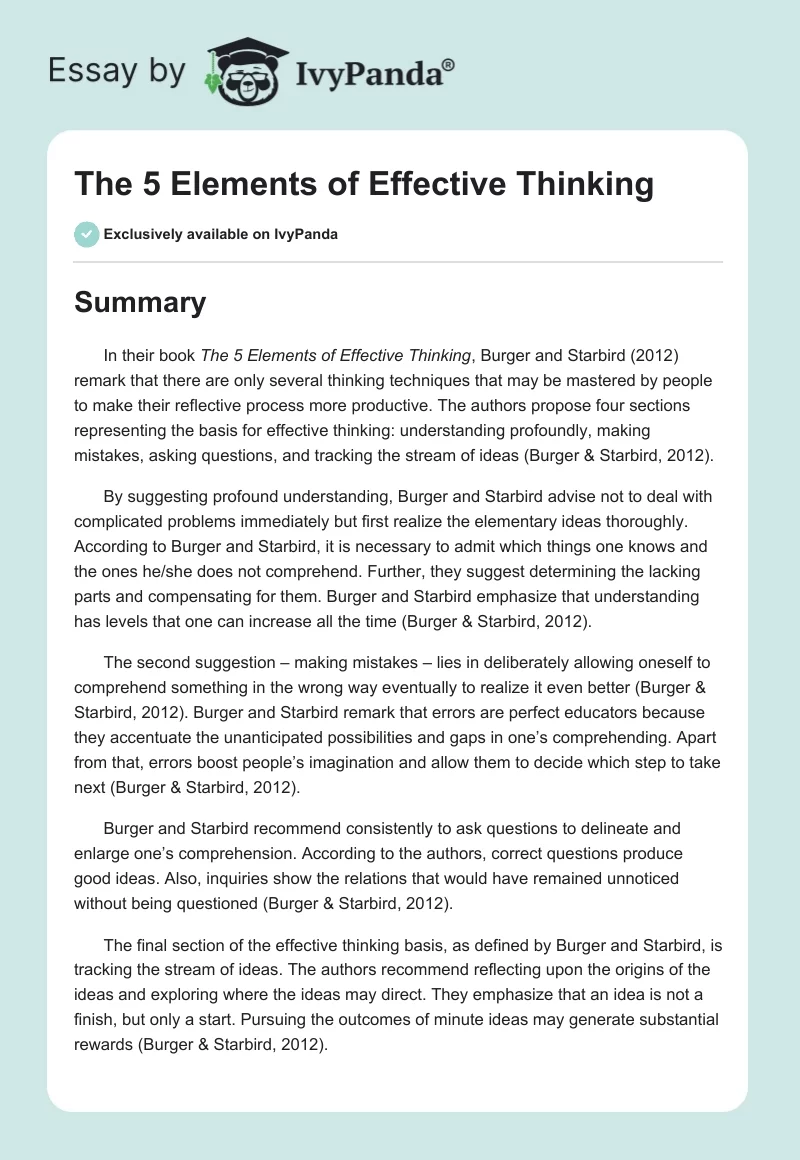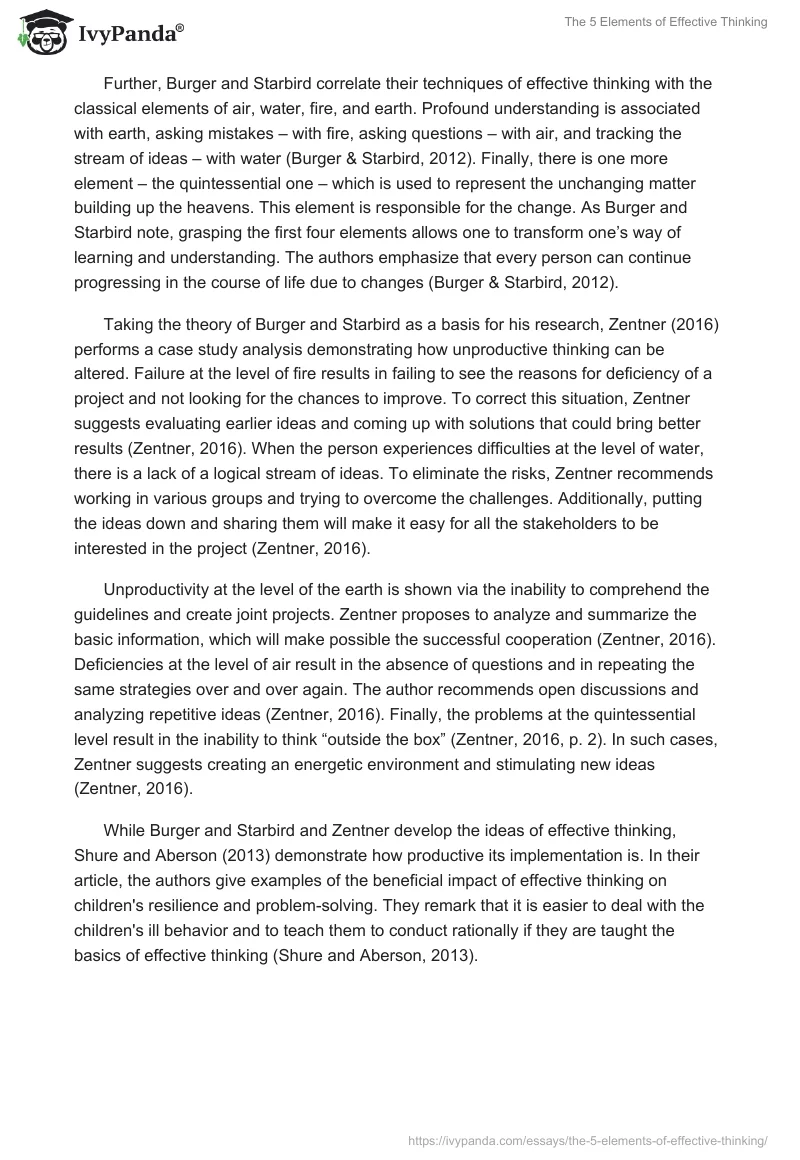Summary
In their book The 5 Elements of Effective Thinking, Burger and Starbird (2012) remark that there are only several thinking techniques that may be mastered by people to make their reflective process more productive. The authors propose four sections representing the basis for effective thinking: understanding profoundly, making mistakes, asking questions, and tracking the stream of ideas (Burger & Starbird, 2012).
By suggesting profound understanding, Burger and Starbird advise not to deal with complicated problems immediately but first realize the elementary ideas thoroughly. According to Burger and Starbird, it is necessary to admit which things one knows and the ones he/she does not comprehend. Further, they suggest determining the lacking parts and compensating for them. Burger and Starbird emphasize that understanding has levels that one can increase all the time (Burger & Starbird, 2012).
The second suggestion – making mistakes – lies in deliberately allowing oneself to comprehend something in the wrong way eventually to realize it even better (Burger & Starbird, 2012). Burger and Starbird remark that errors are perfect educators because they accentuate the unanticipated possibilities and gaps in one’s comprehending. Apart from that, errors boost people’s imagination and allow them to decide which step to take next (Burger & Starbird, 2012).
Burger and Starbird recommend consistently to ask questions to delineate and enlarge one’s comprehension. According to the authors, correct questions produce good ideas. Also, inquiries show the relations that would have remained unnoticed without being questioned (Burger & Starbird, 2012).
The final section of the effective thinking basis, as defined by Burger and Starbird, is tracking the stream of ideas. The authors recommend reflecting upon the origins of the ideas and exploring where the ideas may direct. They emphasize that an idea is not a finish, but only a start. Pursuing the outcomes of minute ideas may generate substantial rewards (Burger & Starbird, 2012).
Further, Burger and Starbird correlate their techniques of effective thinking with the classical elements of air, water, fire, and earth. Profound understanding is associated with earth, asking mistakes – with fire, asking questions – with air, and tracking the stream of ideas – with water (Burger & Starbird, 2012). Finally, there is one more element – the quintessential one – which is used to represent the unchanging matter building up the heavens. This element is responsible for the change. As Burger and Starbird note, grasping the first four elements allows one to transform one’s way of learning and understanding. The authors emphasize that every person can continue progressing in the course of life due to changes (Burger & Starbird, 2012).
Taking the theory of Burger and Starbird as a basis for his research, Zentner (2016) performs a case study analysis demonstrating how unproductive thinking can be altered. Failure at the level of fire results in failing to see the reasons for deficiency of a project and not looking for the chances to improve. To correct this situation, Zentner suggests evaluating earlier ideas and coming up with solutions that could bring better results (Zentner, 2016). When the person experiences difficulties at the level of water, there is a lack of a logical stream of ideas. To eliminate the risks, Zentner recommends working in various groups and trying to overcome the challenges. Additionally, putting the ideas down and sharing them will make it easy for all the stakeholders to be interested in the project (Zentner, 2016).
Unproductivity at the level of the earth is shown via the inability to comprehend the guidelines and create joint projects. Zentner proposes to analyze and summarize the basic information, which will make possible the successful cooperation (Zentner, 2016). Deficiencies at the level of air result in the absence of questions and in repeating the same strategies over and over again. The author recommends open discussions and analyzing repetitive ideas (Zentner, 2016). Finally, the problems at the quintessential level result in the inability to think “outside the box” (Zentner, 2016, p. 2). In such cases, Zentner suggests creating an energetic environment and stimulating new ideas (Zentner, 2016).
While Burger and Starbird and Zentner develop the ideas of effective thinking, Shure and Aberson (2013) demonstrate how productive its implementation is. In their article, the authors give examples of the beneficial impact of effective thinking on children’s resilience and problem-solving. They remark that it is easier to deal with the children’s ill behavior and to teach them to conduct rationally if they are taught the basics of effective thinking (Shure and Aberson, 2013).
Reflection
The ideas suggested by Burger and Starbird (2012), Shure and Aberson (2013), and Zentner (2016) present an innovative approach to effective thinking management. The authors propose easy and animated ways of enriching one’s thinking possibilities and making one’s life more engaging and worthwhile. By employing effective thinking, people can radically change their lives, reach their goals, fulfill their aspirations, and become more open-minded and successful.
The approaches recommended by Burger and Starbird and further developed by Shure and Anderson and Zentner provide an opportunity for self-discovery and self-improvement. Having effective thinking as a tool, one can learn how to calculate the risks and not be afraid to face them, how to draw lessons from one’s errors, and how to revolutionize oneself into a more attentive and reflective person.
References
Burger, E. B., & Starbird, M. (2012). The 5 elements of effective thinking. Princeton, NJ: Princeton University Press.
Shure, M.B., & Aberson, B. (2013). Enhancing the process of resilience through effective thinking. In S. Goldstein & R. B. Brooks (Eds.), Handbook of resilience in children (2nd ed.) (pp. 481-506). New York, NY: Springer.
Zentner, A. (2016). Effective thinking strategy: Five elements to facilitate ideation.SSRN Electronic Journal, 1-2. Web.


